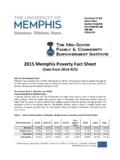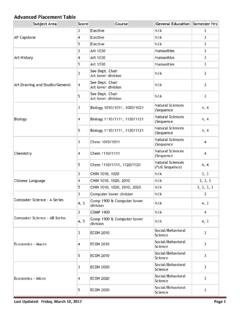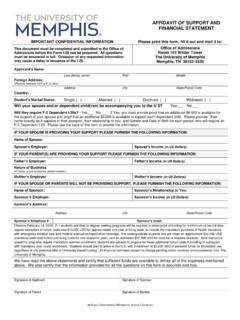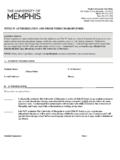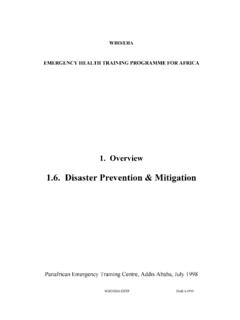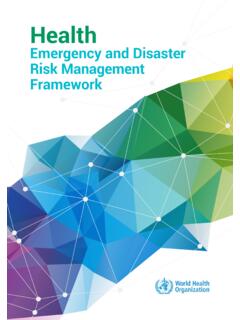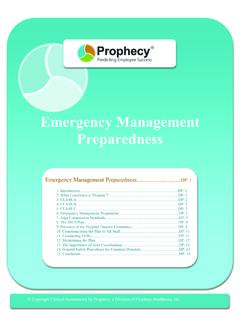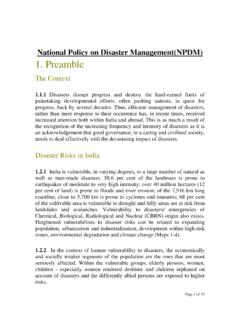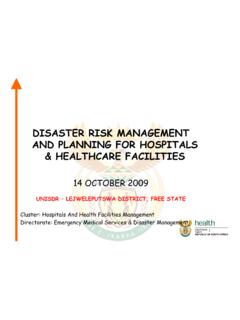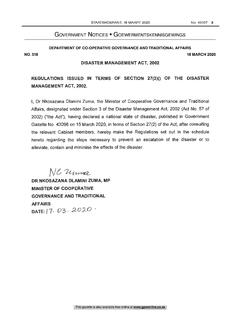Transcription of The Recovery Phase of Emergency Management
1 The Recovery Phase of Emergency Management Background Paper Prepared for the Intermodal Freight Transportation Institute (IFTI). University of Memphis Prepared by Malcolm E. Baird, , Vanderbilt Center for Transportation Research (VECTOR). January 2010. Contents Page Preface .. i Abstract .. ii Recovery is Complex and Has Many Stakeholders .. 2. Short-Term Versus Long-Term Recovery .. 7. Conceptual Models of Recovery .. 11. Business Recovery .. 19. Is Recovery Neglected? .. 26. Closing .. 31. References .. 32. Preface This paper was prepared for the Intermodal Freight Transportation Institute (ITFI) at the University of Memphis to help advance research, education, and outreach related to intermodal freight transportation. The primary audience for the paper includes IFTI faculty, staff, and students as well as representatives of the public and private organizations that support IFTI. The paper is part of an ITFI initiative to improve mutual understanding between the public and private sectors relative to intermodal freight transportation.
2 Many of the referenced documents are available online, and links are provided in the text or in the list of references. The report was sponsored in part by funds from the federal Safe, Accountable, Flexible, Efficient Transportation Equity Act: A Legacy for Users (SAFETEA-LU) and by an unrestricted gift to Vanderbilt University from the Ingram Barge Company. Appreciation is expressed to the USDOT, the Tennessee Department of Transportation, and Ingram Barge and to the individuals who provided assistance in preparing and reviewing the paper. The author is solely responsible for the content, findings, and conclusions. i Abstract Emergency Management is often described in terms of phases or components, using terms such as mitigation, preparedness, response, and Recovery . Some sources add or substitute different terms, but virtually every source policy documents, plans, manuals, textbooks, journals, and research reports . agree that Recovery is an essential part of Emergency Management .
3 This paper examines disaster Recovery , focusing on the complexity of issues, multiple stakeholders, distinctions between short- and long-term Recovery , conceptual models of community Recovery , and the Recovery of businesses impacted by disasters. The purpose is to provide background information for transportation researchers and practitioners. The paper also addresses the question of whether Recovery has been neglected by researchers, practitioners, and policy makers. Part of the answer seems to be that the current focus is more on eliminating or reducing the need for Recovery . The public sector is emphasizing prevention, protection, reduced vulnerability, increased sustainability, and improved resilience. Likewise, the private sector is giving increased attention to risk Management and related concepts. Nonetheless, disasters will occur and Recovery will be required. Whether or not Recovery has been the most neglected Phase of Emergency Management in the past, transportation researchers and practitioners now have important opportunities to influence research and policy development related to Recovery .
4 Ii The Recovery Phase of Emergency Management The purpose of this paper is to provide an overview of the Recovery Phase of Emergency Management in the United States and to identify sources and potential topics for more focused research. In this context, Recovery is one of multiple phases or components, usually described as: Mitigation Preparedness Response Recovery Some sources add prevention or protection as separate components. Others modify mitigation to mitigation and prevention. Others expand or integrate the notion of Phase or components with concepts such as disaster -resistance, sustainability, and resilience. The private sector is more likely to use terms like contingency planning, business continuity, and risk Management . 1. The word Phase is used in this paper interchangeably with component, activity, aspect and function. The term Emergency Management is used here to encompass all of the activities carried out by the federal, state, and local agencies that are referred to as Emergency Management agencies (EMAs), and, more broadly, the efforts of the public and private sectors to deal with hazards, risks, and disasters of all types.
5 Alternative definitions are examined for a few other key terms used in the paper, but many terms are used without offering specific definitions. Readers should be alert for unusual or multiple meanings. Words and phrases that have specific meanings among Emergency Management practitioners may have different meanings in the transportation arena. In addition, since Emergency Management is an interdisciplinary field of study, the languages of multiple disciplines are intertwined. Since the primary audience for the paper is focused on transportation, transportation examples and comparisons are used in many sections. This paper is divided into five sections, beginning on the next page: Recovery is Complex and Has Many Stakeholders Short-Term Versus Long-Term Recovery Conceptual Models of Recovery Business Recovery Is Recovery Neglected? Recovery IS COMPLEX AND HAS MANY STAKEHOLDERS. 1. A companion background paper, The Phases' of Emergency Management , provides definitions and descriptions for all of the phases/components of Emergency Management and examines related concepts.
6 1. Virtually every source examined policy documents, plans, manuals, textbooks, journals, and research materials agree that Recovery is an essential part of Emergency Management . These sources also agree that successful Recovery , however defined, is very dependent on what happens during the other phases. Most sources even agree, at least generally, on the goals of Recovery something along the lines of returning the community, business, or other entity to conditions the same or better than existed before the disrupting event. Most sources also agree that the Recovery component of Emergency Management is more complex than the other components and involves a much larger group of diverse stakeholders with sometimes- conflicting objectives. The Introduction to Emergency Management makes these observations about Recovery : Unlike the response function, where all efforts have a singular focus, the Recovery function or process is characterized by a complex set of issues and decisions that must be made by individuals and communities.
7 Recovery involves decisions and actions relative to rebuilding homes, replacing property, resuming employment, restoring businesses, and permanently repairing and rebuilding infrastructure. The Recovery process requires balancing the more immediate need to return the community to normalcy with the longer-term goal of reducing future vulnerability.. Because the Recovery function has such long-lasting effects and usually high costs, the participants in the process are numerous. They include all levels of government, the business community, political leadership, community activists, and individuals. Each of these groups plays a role in determining how the Recovery will progress. (Haddow 2008). The following is from a summary of the October 17, 2007 Workshop of the Disasters Roundtable sponsored b the National Academies: disaster Recovery is a complex and challenging process that involves all sectors of a community as well as outside interests.
8 In many cases, it is not even clear if and when Recovery has been achieved because of varying stakeholder goals for the community, for example with some wanting it returned to what is considered its pre- disaster status and others wanting it to undergo change to realize a vision in which advances are made in risk reduction and other areas. (Anderson 2008). The choice between snap back (Rubin 2009) and a more visionary approach is only one of the possible conflicts that have to be addressed. Others include setting priorities on neighborhoods and other geographic areas ( , neighborhood A or neighborhood B or downtown) and deciding which types and sections of infrastructure come first, which human services are most important, and what assistance will be provided for businesses. Will demolition be allowed at will? Where will debris be placed? Will building codes, zoning regulations, or subdivision regulations be revised? And, of course, where will the money come from?
9 And, who will benefit and who will pay? FEMA's guidelines for state and local Emergency plans, Developing and Maintaining State, Territorial, Tribal, and Local Government Emergency Plans, Comprehensive Preparedness Guide 101, defines Recovery as including all of the following: 2. The development, coordination, and execution of service- and site-restoration plans the reconstitution of government operations and services individual, private-sector, nongovernmental, and public assistance programs to provide housing and to promote restoration long-term care and treatment of affected persons additional measures for social, political, environmental, and economic restoration evaluation of the incident to identify lessons learned post incident reporting development of initiatives to mitigate the effects of future incidents. (FEMA 2009). Note especially the bulleted item near the middle of the list, additional measures for social, political, environmental, and economic restoration.
10 The FEMA document does not elaborate on those additional measures, but the possibilities are extensive, especially following a major disaster that affects a large geographic area. Daniel Alesch developed the schematic shown in Figure 1 to illustrate what he calls the cascading consequences of extreme events. The immediate consequences of an extreme event are often relatively easy to quantify and comprehend. However, the systemic community consequences depend on a number of secondary events and the reverberations in the community and the outside world.. Figure 1. Relationships Among the Cascading Consequences of Extreme Events (Alesch 2007). Katrina came ashore over a wide section of the Gulf Coast causing immediate consequences damage to infrastructure, homes, and businesses but the systemic community consequences were different in 3. different communities over different periods of time, affected by immediately following events, ripple effect consequences, and ripple reverberation consequences.

